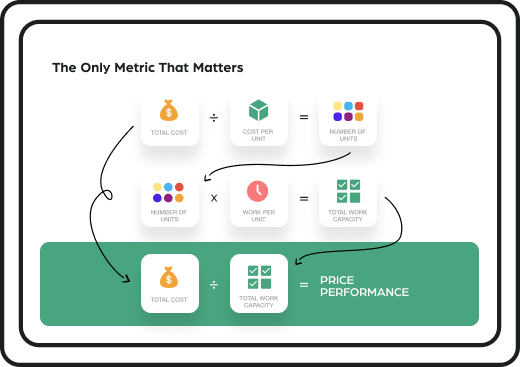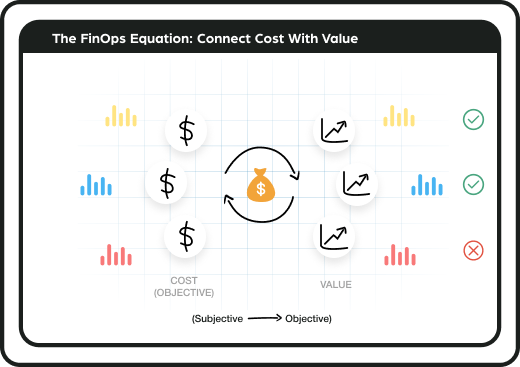
Cloud spending is difficult to control, and it isn’t getting any easier given the growing reliance on complex, multi-cloud environments in many organizations. It’s time for customers to take the initiative and go beyond relying entirely on the limited scope of the cost management tools provided by cloud vendors themselves.
This is exactly where FinOps comes in, not as a competing force to conventional cloud cost management but as a broader approach spanning the optimization and cost management of the entire cloud operating model. It provides a way for organizations to pinpoint exactly where their cloud investment is going, while bringing teams together to make collaborative decisions.
What is Cloud Cost Management?
Cloud cost management, also called cloud cost optimization or cloud financial management, is the process of understanding and managing the cloud costs in your organization. As cloud infrastructure becomes more complex, involving many factors that contribute to rising bills, there is a growing need for usage to be monitored and managed properly and proactively.
Public cloud vendors often provide cloud cost management solutions. These are targeted toward IT teams who need to justify their cloud expenses to the finance department or chase DevOps teams to correctly tag and allocate resources. While the process contributes to monitoring and forecasting costs and keeping track of financial expenses incurred by using cloud resources, it’s largely restricted to short-term initiatives and use in the IT department.
A popular example of a cloud cost management tool is the AWS Cost Management console for Amazon Web Services customers. It is closely integrated with the AWS billing console to help teams manage their costs more holistically. For example, they can use AWS Cost Explorer to visualize their AWS costs across different availability zones and services or use the AWS Cost Anomaly Detection tool to quickly detect unusual spending instances. What it doesn’t do, however, is provide any insight into things like your cost per customer.
How Does FinOps Build on Cloud Cost Management?

While cloud cost management is relatively narrow in scope and aims to solve more immediate problems within the IT department, FinOps is better defined as a cultural practice and a long-term process that becomes deeply ingrained into an organization. Cloud cost management is essentially a component of a FinOps strategy, so the two aren’t mutually exclusive, and neither are they competing forces.
What makes FinOps fundamentally broader than cloud cost management is that it depends on a team that spans the entire organization and all the personas involved in generating cloud costs and allocating funds. To that end, it focuses on bridging the gaps between finance and IT to continuously improve cost efficiency. At the head of this process is a FinOps practitioner responsible for overseeing the adoption of best practices via training and communication.
Whereas cloud cost management is primarily an IT responsibility, FinOps sees everyone take ownership of their cloud usage, regardless of their role and department. This includes, but isn’t limited to:
- CEOs who want to ensure that cloud investments align with business objectives, such as revenue growth and gross margins.
- CTOs and CIOs who seek to align technology strategy with business objectives, so they’ll be responsible for overseeing the output of engineering teams.
- CFOs need granular visibility into cloud expenses so they can understand what it costs to maintain a particular client, feature, or service, in terms of unit cost economics.
- R&D teams need to know which features to implement and improve upon in order to enhance cost efficiency.
- Product owners need to know how to optimally price their products and services that depend on cloud-hosted resources to function.
- Procurement teams are responsible for negotiating the most profitable contracts with cloud vendors.
By bringing all these players together under the umbrella of FinOps, everyone has ownership of their cloud usage and has a role in continuously enhancing cost efficiency.
Which Data Does Your Business Need to Empower a FinOps Process?
While FinOps is first and foremost a cultural practice, its data-driven nature means that there are various important tools that make up the FinOps software stack. These include cloud cost management tools, such as those provided by cloud vendors themselves, as well as third-party solutions that provide more granular visibility for specific departments and operations.
The question that engineering teams face is how to choose the right architecture for a given workload. The answer isn’t always obvious, which is where the more comprehensive view of FinOps, compared to basic cloud cost optimization, comes in. A FinOps solution will directly align cloud costs with the KPIs that matter to a specific team. For example, engineering teams responsible for architecting cloud services and implementing features will be interested in unit economics, like the cost of operating a specific feature or carrying out a specific transaction.
By contrast, finance teams are more likely to be interested in cost-per-customer reports that allow them to see the financial impact that individual customers (or any other end users) have on the business. If, for example, one customer is bringing in an unsatisfactory return on investment because they’re using a feature or service much more than others, then it may be time to renegotiate their contract when the time comes. If the cost per customer is rising across the board, it might be time for sales teams to adapt their pricing structures.
The ultimate goal of FinOps is to break down your cloud costs by KPIs to provide unit economics such as customers, teams, product features, and even individual transactions — so that you can know exactly where your cloud budget is being spent and the return on investment it brings. To that end, FinOps extends far beyond the realms of the DevOps department for the betterment of the business at large. Finout provides total visibility into your cloud costs to reveal opportunities for optimization and drive informed, data-driven decision-making among engineers and finance leaders alike. Get in touch with us today to try a one-month-free proof of concept.








